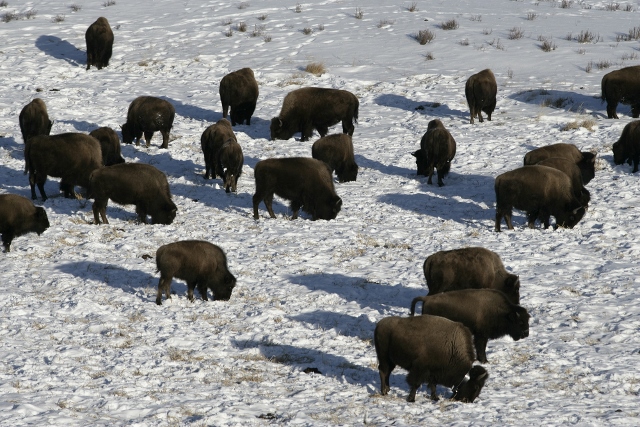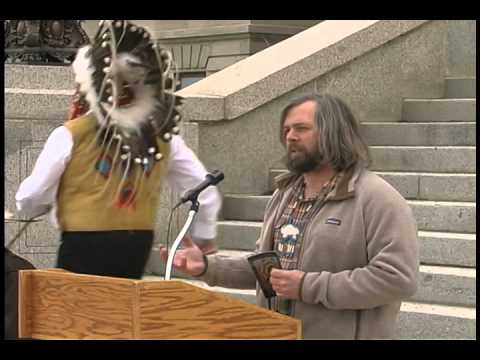The amazing bison, revered by Native Americans, survives despite its continued sacrifice at the demand of the cattle industry. While slaughter continues at the borders of Yellowstone National Park, bison managers consider alternative management policies. Also watch the documentary, Silencing the Thunder.
Documentary: Silencing the Thunder, By Eddie Roqueta and Forest Clay Productions
Bison or Buffaloes and Native Americans
Published by Buffalo Field Campaign
The bison slaughter, precipitated by Nineteenth Century world views and conditions, is seen as a closed chapter in the history of the West. It is viewed from the standpoint of the Twentieth Century as a necessary but somewhat regrettable evil. Most of all, it is considered a completed event, something that had to be done once and for all. The Indians were put on reservations, the bison on ranches; end of story. Or is it?
This struggle, between white and Indian, between cattle and bison, between two strikingly dissimilar ways of life, is alive and strong today. The extirpation of the herds in the last century and the current slaughter taking place outside Yellowstone National Park are closely related and fueled by many of the same economic motivations, personal fears, and misunderstandings. The bison were exterminated as a means of creating and maintaining the dominance of the cattle culture across the Great Plains and the West. In the second decade of the Twenty-first Century, many of the same forces are still in place.
STORY: Love Trials of the Magic Buffalo Wife — Mythology of the Crow
Government and tribal managers are considering six alternative Yellowstone Bison management options to the bitter debate over keeping the population at 3,000,with permitted killing of those migrating into Montana for winter forage. Submitted by agencies including the state of Montana and the National Park Service, alternatives are open for public comment until June 15. The options range from one in which Yellowstone would be home to thousands more bison without severe culling to a plan that would likely see many more of the massive, hump-shouldered creatures targeted for death. — Reuters
From Infinite to Decimated
Buffalo once ranged from the eastern seaboard to Oregon and California; from Great Slave Lake in northern Alberta to northern Mexico. Although no one will ever know exactly how many bison once inhabited North America, estimates range from twenty-five to seventy million. William Hornaday, a naturalist who spent considerable time in the West, both before and during the most severe years of the slaughter, comments on the seemingly infinite bison population and the impossibility of estimating their quantity:
It would have been as easy to count or to estimate the number of leaves in a forest as to calculate the number of buffaloes living at any given time during the history of the species previous to 1870 (quoted in Rifkin, 74).


The great herds were not decimated overnight. The slaughter was a gradual process, reaching full momentum in the 1870s. It started with the Indians, who had relied upon and hunted buffalo for thousands of years. Without the arrival of the whites–and with them the gun, the horse, and the market for bison–the Indians probably could have lived in perpetuity with the bison. But with horse and gun–which plains tribes received from their southern neighbors who, in turn, received them from the Spanish–the Indians were able to kill buffalo with greater ease. As the market for buffalo, particularly their hides, emerged in the 1820s, the bison population began to decline.
In the years following the Civil War demand for beef, hides, and tallow skyrocketed as the North began to rebuild its economy and expand its industrial base. (This increased emphasis on industrialization simultaneously increased demand for buffalo hides, which provided a strong yet elastic material from which to make belts to drive machinery.) The growing middle and upper classes had a nearly insatiable appetite for beef, and the postwar economic boom gave them the buying power to satisfy it. Texas alone could not feed the demand. In response ranchers turned to the western plains, a vast area that had already demonstrated its ability to sustain large and healthy populations of ungulates.
But first, the plains’ inhabitants–the Indian and the buffalo–had to be removed . This fit in well with the U.S. government’s agenda of “civilizing” or assimilating the Indians. Their nomadic way of life, dictated by the migrations of buffalo, deer, and elk, did not lend itself to the European notion of private property ownership and flew in the face of white attempts to fence and segregate tracts of land for individual use. Cattlemen formed alliances with the U.S. Army, the railroads, and eastern bankers to rid the western range of both the buffalo and the Indian (Rifkin, 73).
No reasonable solution is possible as long as the livestock industry is in charge, in part, because disease control is not the real issue—rather the slaughter of bison is as much about keeping wildlife bottled up in Yellowstone Park and off other public lands as anything to do with protecting Montana’s livestock from disease. — George Wuerthner
The Great Provider
The establishment of reservations was an attempt to tame the Indians of their nomadism and to establish clear boundaries between Indian and non-Indian lands. Some treaties “protected” the Indian’s right to hunt buffalo in perpetuity, so long as the buffalo remained.
Western settlers were threatened by the nomadic ways of the plains Indians, who for thousands of years had lived migratory lives following the great herds of buffalo. To these people, the buffalo was the ultimate resource. It provided not only food, clothing, and shelter but nearly every material need. Because the Indians of the plains depended so much on the bison for their existence, their very religions were centered around the buffalo. This interdependence between Indian and buffalo is exemplified in the beautiful words of John Fire Lame Deer:
The buffalo gave us everything we needed. Without it we were nothing. Our tipis were made of his skin. His hide was our bed, our blanket, our winter coat. It was our drum, throbbing through the night, alive, holy. Out of his skin we made our water bags. His flesh strengthened us, became flesh of our flesh. Not the smallest part of it was wasted. His stomach, a red-hot stone dropped into it, became our soup kettle. His horns were our spoons, the bones our knives, our women’s awls and needles. Out of his sinews we made our bowstrings and thread. His ribs were fashioned into sleds for our children, his hoofs became rattles. His mighty skull, with the pipe leaning against it, was our sacred altar. The name of the greatest of all Sioux was Tatanka Iyotake–Sitting Bull. When you killed off the buffalo you also killed the Indian–the real, natural, “wild” Indian (Fire, 130).
STORY: Yellowstone and Glacier Through Native Eyes
In the 1870s, more buffalo were killed than in any other decade in history. The three years of 1872, ’73, and ’74 were the worst. According to one buffalo hunter, who based his calculations on first-hand accounts and shipping records, 4.5 million buffalo were slaughtered in that three year period alone (Mayer, 87).
Influenced by forces discussed above, the U.S. government pursued a policy to eradicate the buffalo and thereby extinguish the Indians’ very sustenance, forcing them onto reservations. The following speech, recounted by John Cook–a buffalo hunter, was delivered by General Phil Sheridan to the Texas legislature in 1875. The legislature, as the story goes, was discussing a bill to protect the buffalo when the General took the floor in opposition:
These men have done more in the last two years, and will do more in the next year, to settle the vexed Indian question, than the entire regular army has done in the last forty years. They are destroying the Indians’ commissary. And it is a well known fact that an army losing its base of supplies is placed at a great disadvantage. Send them powder and lead, if you will; but for a lasting peace, let them kill, skin, and sell until the buffaloes are exterminated. Then your prairies can be covered with speckled cattle (Cook, 164).
This testimony, spoken by an Army leader in the Indian wars, spells it out: The buffalo and the Indian were obstructing the march of civilization. Kill the buffalo and not only would the Indian wars be won, but the vast tracks of public land would be opened for cattle.

Watch this video on YouTube
Native American Buffalo & Wolf Rally – Helena, Montana, 2015 – Buffalo Field Campaign.
Updated 23 March 2023









Pingback: Wild Bison to Roam Free Outside Yellowstone | WilderUtopia.com
Pingback: Ecological Amnesia: Life Without Wild Things | WilderUtopia.com
Pingback: Yellowstone and Glacier Through Native Eyes - WilderUtopia